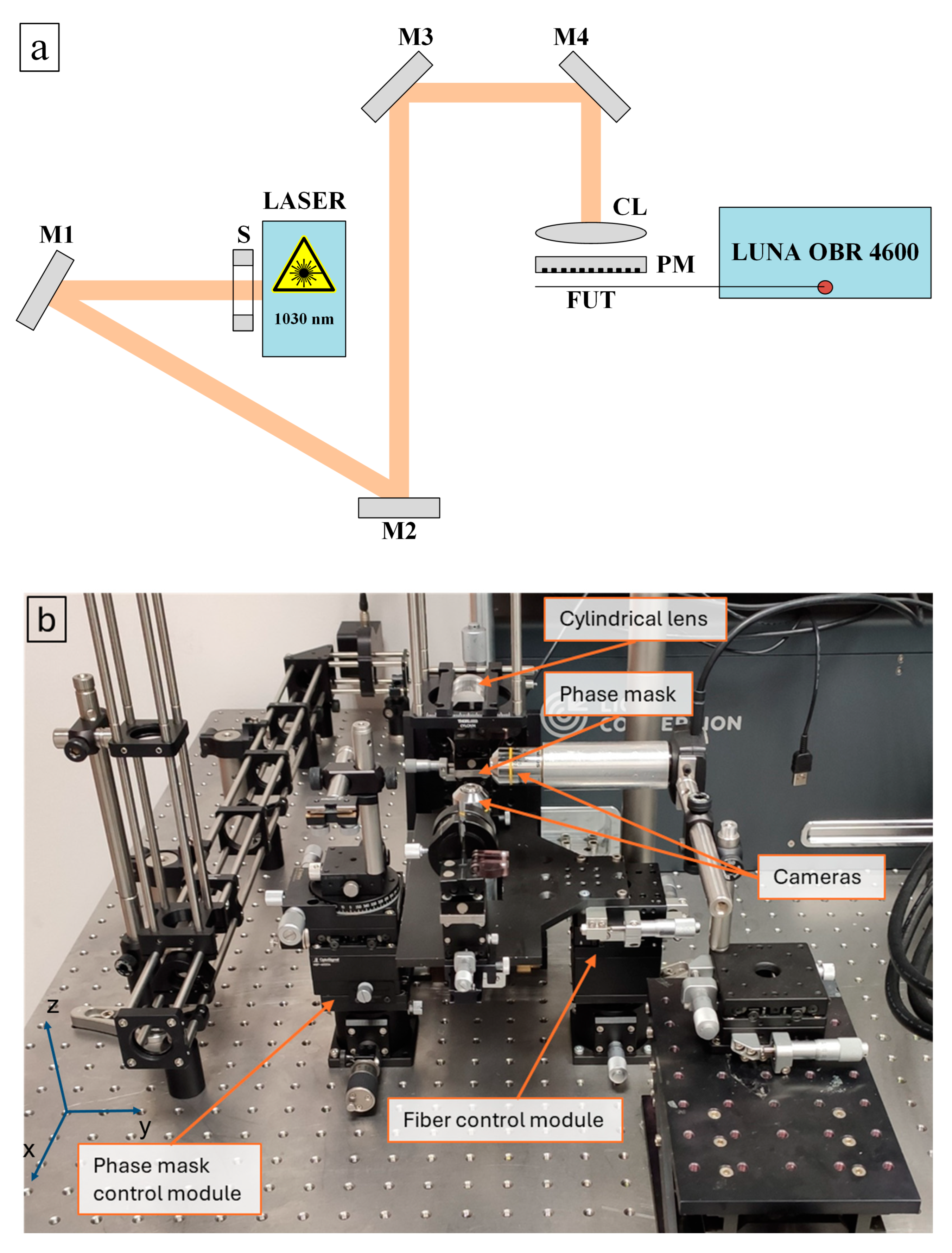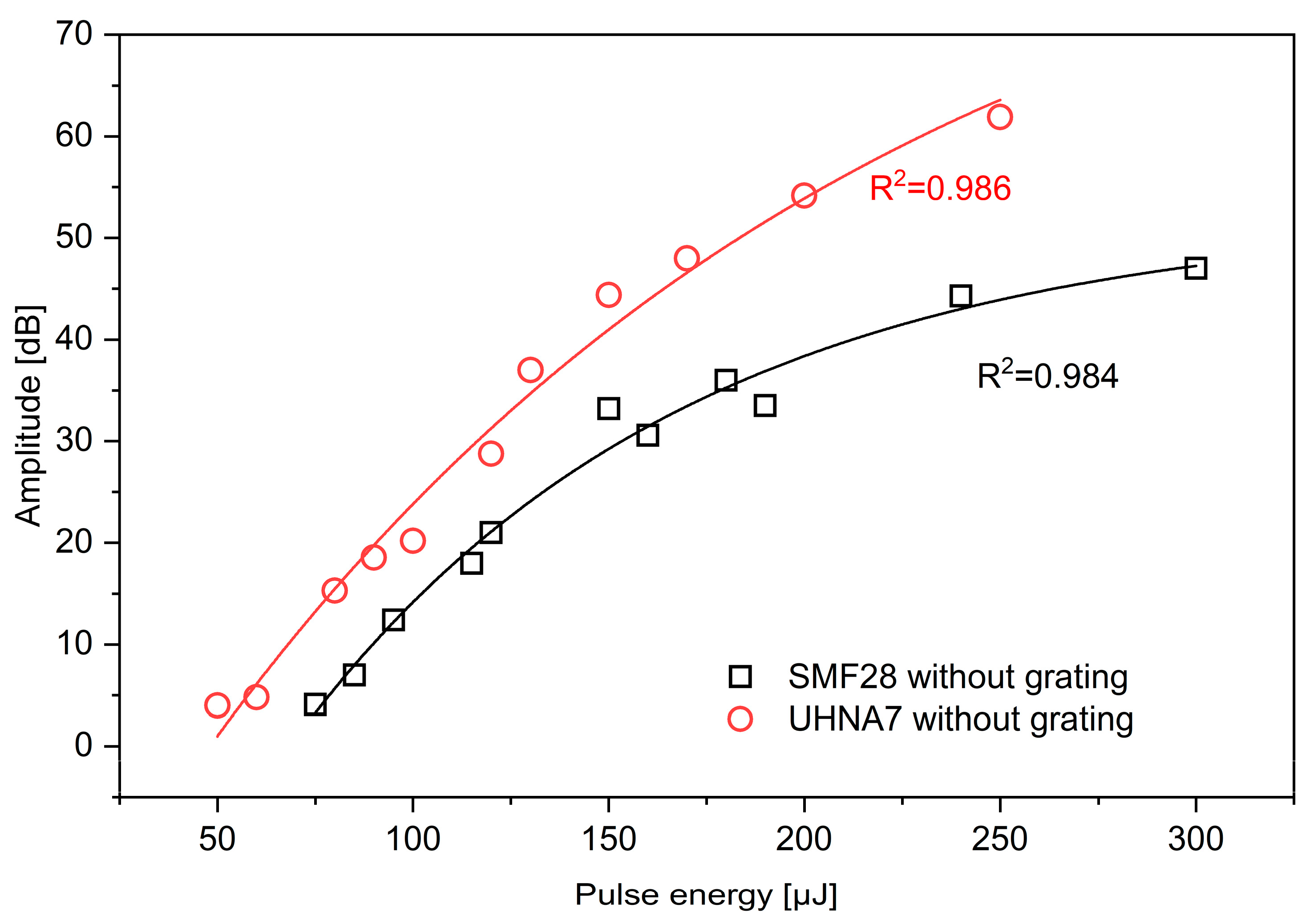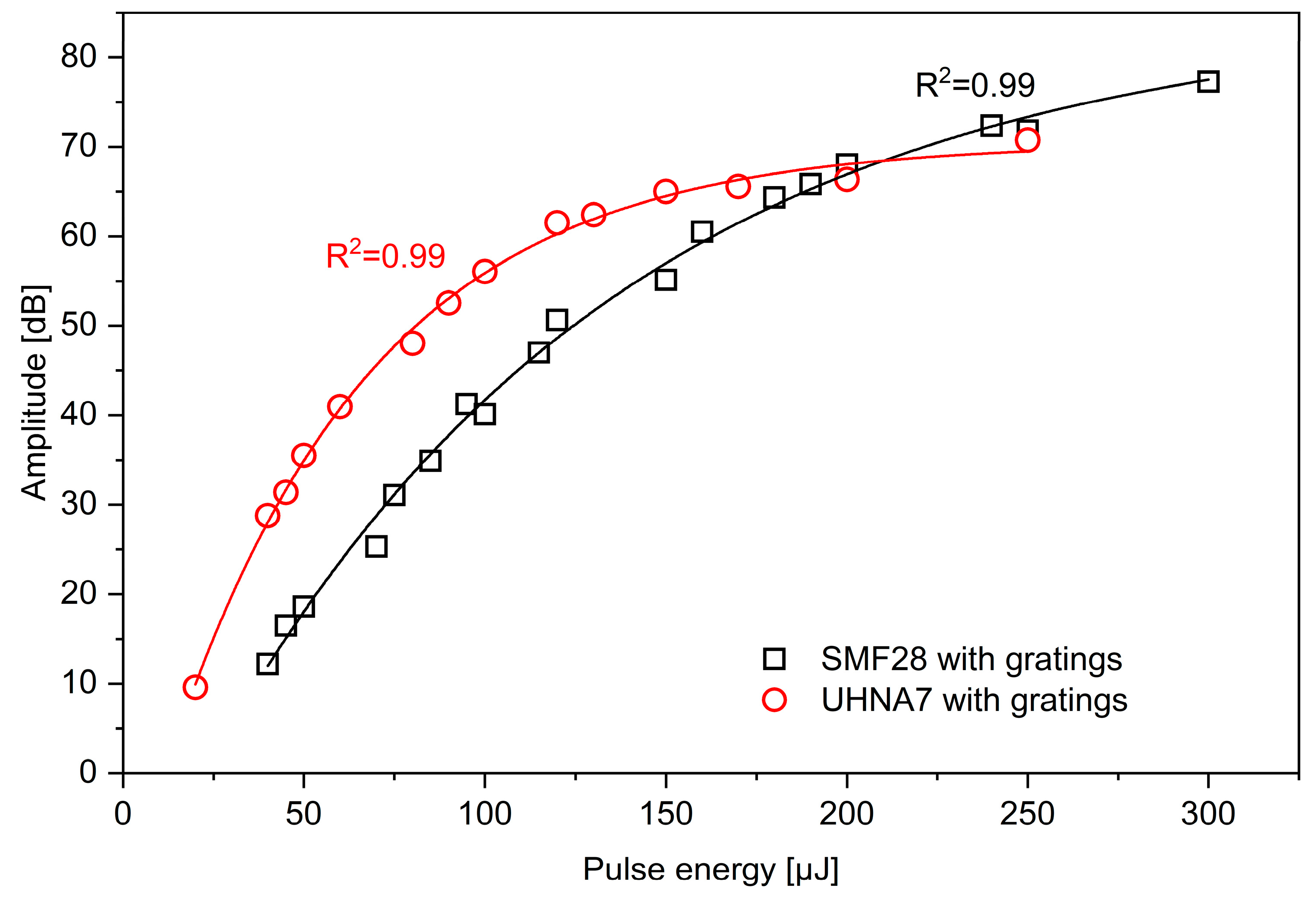The Impact of 1030 nm fs-Pulsed Laser on Enhanced Rayleigh Scattering in Optical Fibers
Abstract
:1. Introduction
2. Materials and Methods
3. Results and Discussion
4. Conclusions
Author Contributions
Funding
Institutional Review Board Statement
Informed Consent Statement
Data Availability Statement
Conflicts of Interest
References
- Liang, C.; Bai, Q.; Yan, M.; Wang, Y.; Zhang, H.; Jin, B. A comprehensive study of optical frequency domain reflectometry. IEEE Access 2021, 9, 41647–41668. [Google Scholar] [CrossRef]
- Palmieri, L.; Schenato, L.; Santagiustina, M.; Galtarossa, A. Rayleigh-based distributed optical fiber sensing. Sensors 2022, 22, 6811. [Google Scholar] [CrossRef] [PubMed]
- Qu, S.; Xu, Y.; Huang, S.; Sun, M.; Wang, C.; Shang, Y. Recent advancements in optical frequency-domain reflectometry: A review. IEEE Sens. J. 2022, 23, 1707–1723. [Google Scholar] [CrossRef]
- Soller, B.J.; Gifford, D.K.; Wolfe, M.S.; Froggatt, M.E. High resolution optical frequency domain reflectometry for characterization of components and assemblies. Opt. Express 2005, 13, 666–674. [Google Scholar] [CrossRef] [PubMed]
- Tosi, D.; Molardi, C.; Sypabekova, M.; Blanc, W. Enhanced Backscattering Optical Fiber Distributed Sensors: Tutorial and Review. IEEE Sens. J. 2021, 21, 12667–12678. [Google Scholar] [CrossRef]
- Lee, T.; Beresna, M.; Masoudi, A.; Brambilla, G. Enhanced-Backscattering and Enhanced-Backreflection Fibers for Distributed Optical Fiber Sensors. J. Light. Technol. 2023, 41, 4051–4064. [Google Scholar] [CrossRef]
- Wang, M.; Zaghloul, M.A.S.B.; Huang, S.; Yan, A.; Li, S.; Zou, R.; Ohodnicki, P.; Buric, M.; Li, M.-J.; Carpenter, D.; et al. Ultrafast laser enhanced Rayleigh backscattering on silica fiber for distributed sensing under harsh environment. In Proceedings of the Conference on Lasers and Electro-Optics (CLEO), San Jose, CA, USA, 13–18 May 2018. [Google Scholar]
- Loranger, S.; Gagné, M.; Lambin-Iezzi, V.; Kashyap, R. Rayleigh scatter based order of magnitude increase in distributed temperature and strain sensing by simple UV exposure of optical fibre. Sci. Rep. 2015, 5, 11177. [Google Scholar] [CrossRef] [PubMed]
- Parent, F.; Gérard, M.; Monet, F.; Loranger, S.; Soulez, G.; Kashyap, R.; Kadoury, S. Intra-arterial image guidance with optical frequency domain reflectometry shape sensing. IEEE Trans. Med. Imaging 2019, 38, 482–492. [Google Scholar] [CrossRef] [PubMed]
- Du, C.; Fu, C.; Li, P.; Meng, Y.; Zhong, H.; Du, B.; Guo, K.; Chen, L.; Wang, Y.; He, J. High-spatial-resolution strain sensor based on Rayleigh-scattering-enhanced SMF using direct UV exposure. J. Light. Technol. 2023, 41, 1566–1570. [Google Scholar] [CrossRef]
- Li, M.-J.; Li, S.; Stone, J.S. Novel optical fibers for distributed sensor applications. In Proceedings of the 25th International Conference on Optical Fiber Sensors (OFS), Jeju, Republic of Korea, 24–28 April 2017. [Google Scholar]
- Szczupak, B.; Olszewski, J.; Madry, M.; Pala, P.; Stefańska, K.; Statkiewicz-Barabach, G. The influence of germanium concentration in the fiber core on temperature sensitivity in Rayleigh scattering based OFDR. IEEE Sens. J. 2021, 21, 20036–20044. [Google Scholar] [CrossRef]
- Ayupova, T.; Shaimerdenova, M.; Korganbayev, S.; Sypabekova, M.; Bekmurzayeva, A.; Blanc, W.; Sales, S.; Guo, T.; Molardi, C.; Tosi, D. Fiber optic refractive index distributed multi-sensors by scattering-level multiplexing with MgO nanoparticle-doped fibers. IEEE Sens. J. 2020, 20, 2504–2510. [Google Scholar] [CrossRef]
- Fuertes, V.; Grégoire, N.; Labranche, P.; Gagnon, S.; Wang, R.; Ledemi, Y.; LaRochelle, S.; Messaddeq, Y. Engineering nanoparticle features to tune Rayleigh scattering in nanoparticles-doped optical fibers. Sci. Rep. 2021, 11, 9116. [Google Scholar] [CrossRef] [PubMed]
- Wang, X.; Benedictus, R.; Groves, R.M. Optimization of light scattering enhancement by gold nanoparticles in fused silica optical fiber. Opt. Express 2021, 29, 19450–19464. [Google Scholar] [CrossRef] [PubMed]
- Bulot, P.; Bernard, R.; Cieslikiewicz-Bouet, M.; Laffont, G.; Douay, M. Performance Study of a Zirconia-Doped Fiber for Distributed Temperature Sensing by OFDR at 800 °C. Sensors 2021, 21, 3788. [Google Scholar] [CrossRef] [PubMed]
- Wang, Q.; Zhao, K.; Badar, M.; Yi, X.; Lu, P.; Buric, M.; Mao, Z.-H.; Chen, K.P. Improving OFDR Distributed Fiber Sensing by Fibers With Enhanced Rayleigh Backscattering and Image Processing. IEEE Sens. J. 2022, 22, 18471–18478. [Google Scholar] [CrossRef]
- Fu, C.; Sui, R.; Peng, Z.; Meng, Y.; Zhong, H.; Shan, R.; Liang, W.; Liao, C.; Yin, X.; Wang, Y. Wide-Range OFDR Strain Sensor Based on the Femtosecond-Laser-Inscribed Weak Fiber Bragg Grating Array. Opt. Lett. 2023, 48, 5819–5822. [Google Scholar] [CrossRef] [PubMed]
- Wajdzik, J.; Pala, P.; Szulc, D.; Bernaś, M.; Bednarek, A.; Chmielowski, P.; Olszewski, J.; Mergo, P.; Statkiewicz-Barabach, G. Determination of dopant concentration in single-mode step-index optical fiber based on measured numerical aperture and mode field diameter. In Proceedings of the SPIE 12502, 22nd Polish-Slovak-Czech Optical Conference on Wave and Quantum Aspects of Contemporary Optics, Wojanow, Poland, 18–22 September 2022. [Google Scholar] [CrossRef]
- Dosunmu, O.I.; Cannon, D.D.; Emsley, M.K.; Ghyselen, B.; Liu, J.; Kimerling, L.C.; Unlu, M.S. Resonant cavity enhanced Ge photodetectors for 1550 nm operation on reflecting Si substrates. IEEE J. Sel. Top. Quantum Electron. 2004, 10, 694–701. [Google Scholar] [CrossRef]
- Lindner, E.; Chojetzki, C.; Brückner, S.; Becker, M.; Rothhardt, M.; Bartelt, H. Thermal regeneration of fiber Bragg gratings in photosensitive fibers. Opt. Express 2009, 17, 12523–12531. [Google Scholar] [CrossRef] [PubMed]
- Tosi, D.; Molardi, C.; Blanc, W.; Paixão, T.; Antunes, P.; Marques, C. Performance analysis of scattering-level multiplexing (SLMux) in distributed fiber-optic backscatter reflectometry physical sensors. Sensors 2020, 20, 2595. [Google Scholar] [CrossRef] [PubMed]
- Beisenova, A.; Issatayeva, A.; Korganbayev, S.; Molardi, C.; Blanc, W.; Tosi, D. Simultaneous Distributed Sensing on Multiple MgO-Doped High Scattering Fibers by Means of Scattering-Level Multiplexing. J. Light. Technol. 2019, 37, 3413–3421. [Google Scholar] [CrossRef]





| Mask Period | Diffraction Order m = | 0 | +1 | −1 | +2 | −2 |
|---|---|---|---|---|---|---|
| 2150 nm | Efficiency [%] | 4.5 | 40.8 | 41.8 | 6.4 | 6.5 |
| 2170 nm | Efficiency [%] | 4.2 | 42.5 | 43.4 | 4.9 | 4.9 |
| Type of Fiber | SMF-28 | UHNA7 |
|---|---|---|
| Core/Cladding Diameter [μm] | 8.2/125 | 2.4/125 |
| Mode Field Diameter (MFD) @1550nm [μm] | 11.1 | 3.3 |
| Core NA (catalog card) | 0.14 | 0.41 |
| Core NA (measured) | 0.149 | 0.47 |
| Germanium Dopant Level [mol%] | 3.5 | 39.8 |
Disclaimer/Publisher’s Note: The statements, opinions and data contained in all publications are solely those of the individual author(s) and contributor(s) and not of MDPI and/or the editor(s). MDPI and/or the editor(s) disclaim responsibility for any injury to people or property resulting from any ideas, methods, instructions or products referred to in the content. |
© 2024 by the authors. Licensee MDPI, Basel, Switzerland. This article is an open access article distributed under the terms and conditions of the Creative Commons Attribution (CC BY) license (https://creativecommons.org/licenses/by/4.0/).
Share and Cite
Szczupak, B.; Mądry, M.; Bernaś, M.; Kozioł, P.; Skorupski, K.; Statkiewicz-Barabach, G. The Impact of 1030 nm fs-Pulsed Laser on Enhanced Rayleigh Scattering in Optical Fibers. Sensors 2024, 24, 5980. https://doi.org/10.3390/s24185980
Szczupak B, Mądry M, Bernaś M, Kozioł P, Skorupski K, Statkiewicz-Barabach G. The Impact of 1030 nm fs-Pulsed Laser on Enhanced Rayleigh Scattering in Optical Fibers. Sensors. 2024; 24(18):5980. https://doi.org/10.3390/s24185980
Chicago/Turabian StyleSzczupak, Bogusław, Mateusz Mądry, Marta Bernaś, Paweł Kozioł, Krzysztof Skorupski, and Gabriela Statkiewicz-Barabach. 2024. "The Impact of 1030 nm fs-Pulsed Laser on Enhanced Rayleigh Scattering in Optical Fibers" Sensors 24, no. 18: 5980. https://doi.org/10.3390/s24185980





